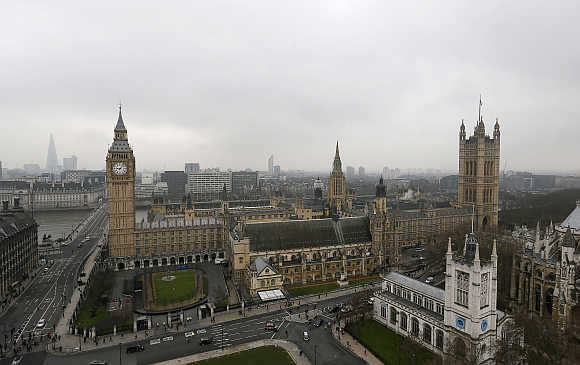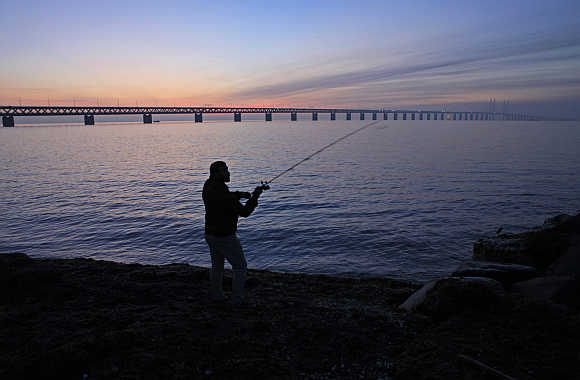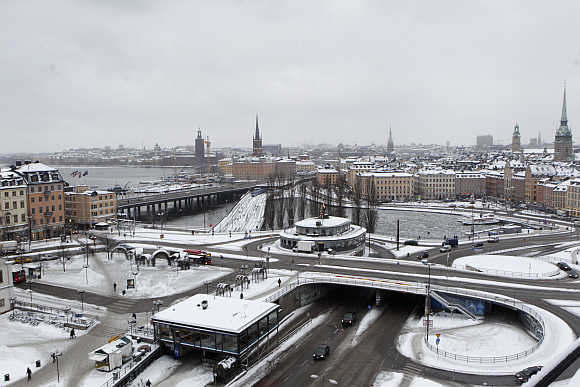 | « Back to article | Print this article |
10 countries most at risk of a financial black hole
Risk analysis firm Maplecroft has studied 163 countries and found that Europe has the least sustainable finances. Of the 10 countries at the most dangerous end of Maplecroft’s Fiscal Risk Index 2011, nine are European. All are rated “extreme risk", according to Allianz.
The Fiscal Risk Index measures the sustainability of a country’s finances based on various criteria including: old-age dependency ratios; labour rates of the over-65s; GDP; debt; and public spending on pensions, health and education, it says.
Let's take a look at 10 economically riskiest countries.
Source: Allianz
Click NEXT to read more...
10 countries most at risk of a financial black hole
The United Kingdom
Fiscal risk rank: 10
While there are 25 old people for every 100 of working age, a ratio of 25 per cent, in the United Kingdom, this is projected to increase to 38 per cent by mid-century. The country spends more than double the worldwide average on pension, making it one of the most generous nations.
In the UK, just around 8 per cent of 65 years and above work whereas the global average is 28 per cent. The government debt has risen from 43 per cent in 2006 to 77 per cent in 2010.
Click NEXT to read more...
10 countries most at risk of a financial black hole
Japan
Fiscal risk rank: 9
By mid-century, Japan will have 74 elderly for every 100 workers, although the saving grace is that about 19 per cent of 65 years and above work, which is more than double of nearly all countries ranked. It has the highest debt-GDP ratio, 203 per cent between 2006 and 2010.
Click NEXT to read more...
10 countries most at risk of a financial black hole
Austria
Fiscal risk rank: 8
Austria spends more than 12 per cent of GDP on the elderly, which is the third-highest in the world and the biggest proportion among the countries ranked. It is projected to have one elderly person for every two workers between 2010 and 2050, with 52 elderly people per 100 working-age citizens by 2050. The good news is that Austria will have 25 children per 100 adults compared to just about 22 in 2010, and its growth rate is better than all nations on the list.
Click NEXT to read more...
10 countries most at risk of a financial black hole
Denmark
Fiscal risk rank: 7
Denmark spends a lot on pensions, it's ranked in top 10 of Maplecroft’s Pensions Index, and is also a huge provider of healthcare costs at 84.7 per cent. The country's old-age dependency ratio of 65 elderly for every 100 working-age people from 2010 until 2050 is also a big economic issue. The positive news is that the government debt is at a manageable 40 per cent of GDP.
Click NEXT to read more...
10 countries most at risk of a financial black hole
Hungary
Fiscal risk rank: 6
It spends about 9 per cent of GDP on pensions on an ageing population, which is a problem as few elderly work past 65 years, only 1.8 per cent. Although the government does not spend that much on heathcare, it takes care of 70 per cent medical bills, it still has debt of more than 72 per cent of GDP.
Click NEXT to read more...
10 countries most at risk of a financial black hole
Germany
Fiscal risk rank: 5
The country spends more than 11 per cent of GDP on pensions, making it the fifth-highest spender in the world. The problem is going to get worse as old age dependency increases from 31 out of 100 people in 2010 to 59 in 2050. Germany will also see a low birth rate, a ratio of just 23 children per 100 by 2050. To alleviate the problem, it has raised the pension age in an effort to keep the elderly working longer.
Click NEXT to read more...
10 countries most at risk of a financial black hole
Sweden
Fiscal risk rank: 4
About 12 per cent of elderly work in Sweden, but its spending makes its one of the most generous nations. Its old-age dependency ratio at 68 per cent in 2010 - the highest among the 10 countries - will decline to 41 per cent by 2050. The government invests a lot on education and also takes care of 82 per cent of medical bills, according to Maplecroft. The silver lining is that its debt level, 41 per cent of GDP, is better off than many other high risk countries.
Click NEXT to read more...
10 countries most at risk of a financial black hole
France
Fiscal risk rank: 3
France, where only 1.4 per cent of elderly work, spends nearly 11 per cent of GDP on pensions, the sixth biggest level in the world. Unlike France, 19 and 12 per cent elderly in Japan and Sweden respectively work. While the old-age dependency ratio will be 55 up to mid-century, the increase in birth rate to 29 children per 100 working-age people in 2050 will help the country in the long term.
Click NEXT to read more...
10 countries most at risk of a financial black hole
Belgium
Fiscal risk rank: 2
Another country that has low proportion of elderly working is Belgium, only 2 per cent, the sixth-lowest figure in the world. In the United States, 17.5 per cent of 65 years old and above work. By 2050, it's estimated that there will be on average 56 elderly people per 100 working-age citizens in Belgium. What's making the problem worse is the debt, 91 per cent of GDP from 2006 to 2010.
Click NEXT to read more...
10 countries most at risk of a financial black hole
Italy
Fiscal risk rank: 1
The country biggest in trouble is Italy, according to Maplecroft. It is projected to have 62 elderly people for every 100 workers by 2050, the fifth-highest old-age dependency ratio in the globe. As less than 4 per cent of 65 years and above work, the government is forced to spend 11.6 per cent of GDP on pension, the fourth-highest level in the world. To make matters worse, the economy has shrunk, saddling the government with debt of 110 per cent of GDP.










